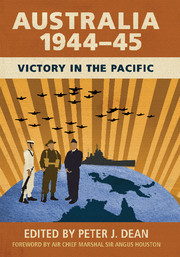Book contents
- Frontmatter
- Dedication
- Foreword
- Contents
- Maps and chart
- Figures and table
- Contributors
- Acknowledgements
- Abbreviations
- Military symbols on maps
- Introduction
- PART 1 STRATEGY
- PART 2 AUSTRALIA AT WAR
- PART 3 GREEN ARMOUR AND SPECIAL OPERATIONS
- PART 4 THE NAVAL AND AIR WAR
- PART 5 THE NEW GUINEA CAMPAIGN
- PART 6 THE BORNEO CAMPAIGN
- Afterword: And Then Came Peace?
- Index
Afterword: And Then Came Peace?
Published online by Cambridge University Press: 05 December 2015
- Frontmatter
- Dedication
- Foreword
- Contents
- Maps and chart
- Figures and table
- Contributors
- Acknowledgements
- Abbreviations
- Military symbols on maps
- Introduction
- PART 1 STRATEGY
- PART 2 AUSTRALIA AT WAR
- PART 3 GREEN ARMOUR AND SPECIAL OPERATIONS
- PART 4 THE NAVAL AND AIR WAR
- PART 5 THE NEW GUINEA CAMPAIGN
- PART 6 THE BORNEO CAMPAIGN
- Afterword: And Then Came Peace?
- Index
Summary
There was great public satisfaction and celebration in Australia when peace came on 15 August 1945, even though many Australians were unsettled by the devastation of the bombs at Hiroshima and Nagasaki that had brought the peace. Australians took pride and courage from the fact that they had faced up to their worst fear, invasion from Asia, that they had stared it down and fought it off. Australian sailors, airmen and soldiers had played crucial roles in the defeat of the Japanese, displaying professionalism, courage, ingenuity and endurance. They had defended their homeland and had protected their loved ones. Their victory was not for some abstract cause like ‘empire’, it was a victory for Australia and all its peoples. The fighting men and women of Australia had every reason to be satisfied and proud: Australians had defended their own.
Many of these men and women returned to their own homes exhausted and unwell. Much of the trauma that occurred in their homes went unreported and unremarked and much of it is only now being openly faced and discussed. In family histories and memoirs, and less directly in all sorts of general histories, we now read of difficulties in adapting to marriage again, of mental health issues that endured for years, and of troubles in the workplace and with alcohol. Family historians will tell, now, of the anger in many marriages after the war. For Australia's sake, many women had loyally accepted the absence of their husbands and had raised their children alone, they had managed the household and had taken all the decisions the home required. They had even worked outside the home where they could in paid employment or in the many ‘good causes’ war encouraged. Now these women were expected to accept, submissively, their husbands’ resumption of all responsibility for family and household matters and were also expected to leave the workforce.
Returning servicemen, after long and difficult years in the jungle, on the seas, in the air and, crucially, in captivity were now expected to put on their overalls, pick up their kitbags or put on their suits and pick up their briefcases to settle down to life as it was before the war.
- Type
- Chapter
- Information
- Australia 1944–45Victory in the Pacific, pp. 341 - 344Publisher: Cambridge University PressPrint publication year: 2015



